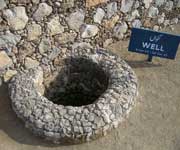Taxila illustrates the different stages in the development of a city on the Indus that was alternately influenced by Persia, Greece and Central Asia and which, from the 5th century B.C. to the 2nd century A.D., was an important Buddhist centre of learning. Taxila lies 30 km north-west of Rawalpindi on the Grand Trunk Road. It is one of the most important archaeological sites in Asia. Situated strategically on a branch of the Silk Road that linked China to the West, the city flourished both economically and culturally. Taxila reached its apogee between the 1st and 5th centuries AD.

Continent: Asia
Country: Pakistan
Category: Cultural
Criterion: (III)(VI)
Date of Inscription: 1980
Taxila Valley Buddhist Monuments
Buddhist monuments were erected throughout the Taxila valley, which was transformed into a religious heartland and a destination for pilgrims from as far afield as Central Asia and China. That Taxila was very famous can be deduced from the fact that it is mentioned in several languages. In Sanskrit, the city was called Takshaçila (Prince of the Serpent Tribe); in Pâli it was known as Takkasilâ; the Greeks knew the town as Taxila, which the Romans rendered as Taxilla; the Chinese called it Chu-ch'a-shi-lo.Taxila is a vast complex of ruins, some 30 km north-west of modern Islamabad, which includes a Mesolithic cave (Khanpur cave), four settlement sites (Saraidala, Bhir, Sirkap and Sirsukh), a number of Buddhist monasteries of various periods and above Giri, Muslim mosques and madrasas of the medieval period. The Bhir mound is the earliest historic city of Taxila and was probably founded in the 6th century BC by the Achaemenids, according to legend by a son of the brother of the legendary hero Rama. The first town was situated on a hill that commanded the river Tamra Nala, a tributary of the Indus. It was an important cultural centre and it is said that the Mahabharata was first recited at Taxila. Stone walls, house foundations and winding streets represent the earliest forms of urbanization on the subcontinent.
 |
| Taxila Pakistan |
Browse Gallery Plus UNESCO Storyline
Taxila the capital of Indus Country
Sirkap was a fortified city founded during the mid-2nd century BC. Taxila was the capital of a kingdom called Hindus (Indus country) and consisted of the western half of the Punjab. It was added to the Achaemenid Empire under Darius I the Great, but the Persian occupation did not last long. The many private houses, stupas and temples are laid out on the Hellenistic grid system and show the strong Western classical influence on local architecture. The city was destroyed in the 1st century AD by the Kushans of central Asia.
To the north, excavations of the ruins of the Kushan city of Sirsukh have brought to light an irregular rectangle of walls in ashlar masonry with rounded bastions. This wall attests to the early influence of Central Asian architectural forms on those of the subcontinent.
The city of Sirkap (Severed Head), chronologically the second major city of Taxila, is to be found spreading down the Hathial Spur and on to the plains of the Taxila valley. It is bounded by the Tamra stream and to the north and south by the Gau stream, which today has been almost completely obliterated by a modern road and water channel. The present layout of the city was established by the Bactrian Greeks sometime around 180 BC and takes the form of a wide and open grid system. In general, the city presents a better planned architecture than Bhir Mound.
The city is encompassed by a mighty wall over 5 km long and up to 6 m thick. There may well have been an entrance on each of the four sides originally, but today the only one evident is the northern wall and it is through here that visitors normally enter the city. A number of temples and monasteries can be found here: Apsidal Temple, Sun Temple, and Shrine of the Double Headed Eagle, Kunala Monastery and Ghai Monastery.
The major attraction in this city is the Great Stupa, one of the largest and most impressive throughout Pakistan, located just 2 km east of Bhir Mound and Sirkap. The chapels and chambers around the Great Stupa were built at various times from the 1st century BC to the post-Kushan period. These structures display a wide range of designs and probably were donated by pilgrims, possibly representing various schools of Buddhism.
Other sites of interest include the city of Sirsukh which is believed to belong to the Kushan period. To the north of Sirkap are four temples, all standing on earlier mounds and overlooking the city. They are all in the style of Greek temples. The best to visit is probably the one at Jandial, 1.5 km north of Sirkap.
Browse All UNESCO World Heritage Sites in
Pakistan. The original UNESCO inscription
Here!!!











No comments:
Post a Comment